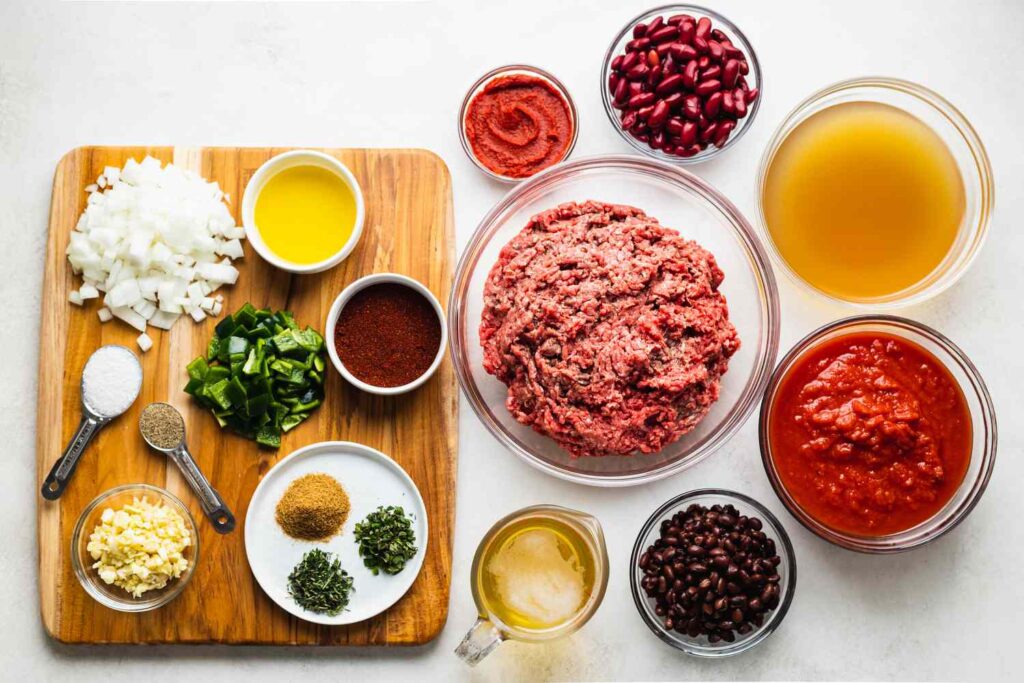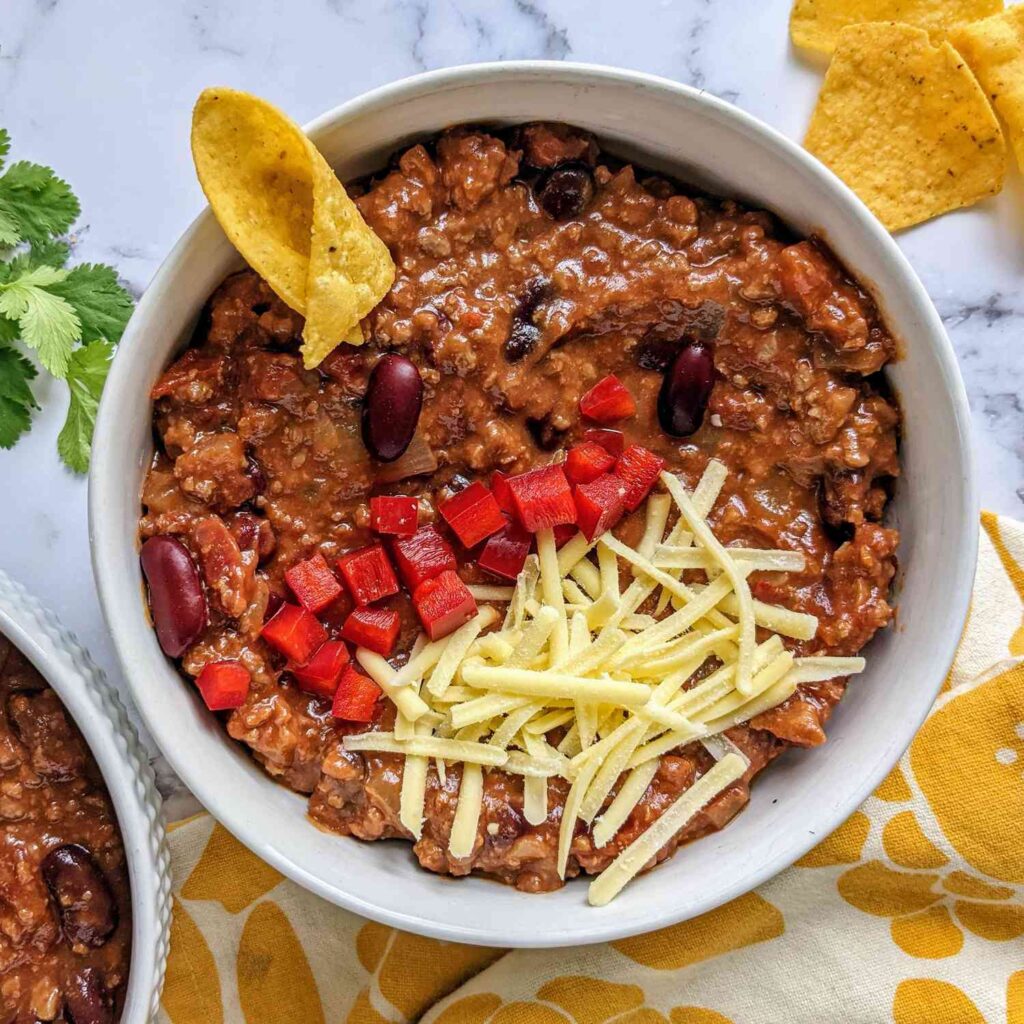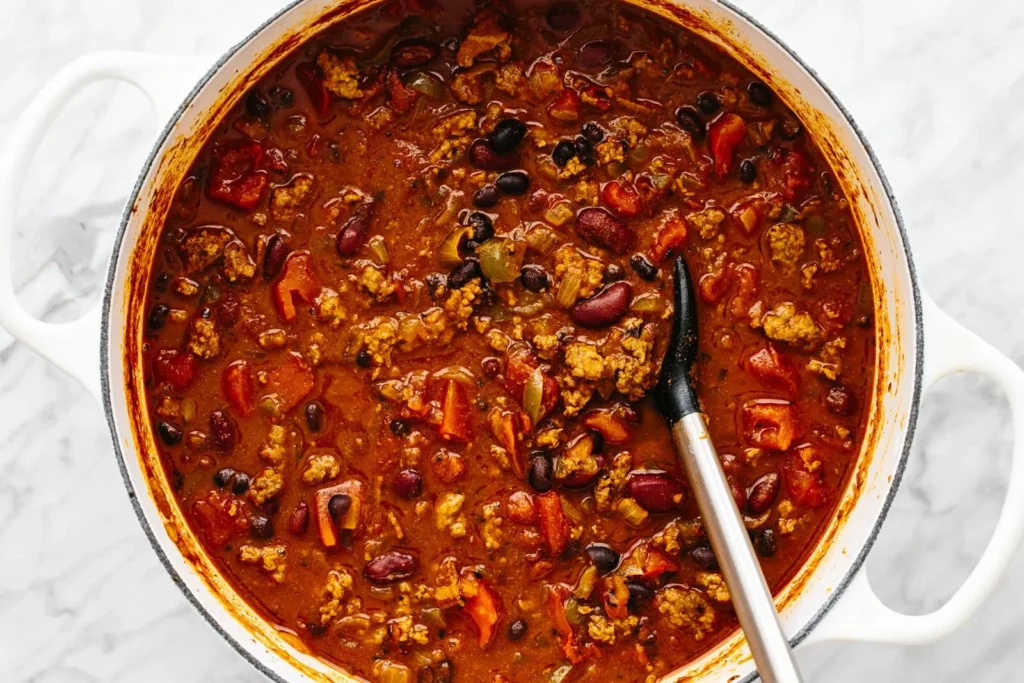Chili recipe with its warm spices and hearty ingredients, is a beloved comfort food that holds a special place in many kitchens. In this comprehensive guide, we’ll explore the art of making chili from scratch, from selecting the perfect ingredients to mastering the cooking techniques that ensure a delicious outcome. Join us as we embark on a culinary adventure and learn how to create a chili recipe that’s both satisfying and soul-warming.
Table of Contents
Understanding the Ingredients: Building Blocks of Flavor
The foundation of any great chili recipe lies in its ingredients. Let’s take a closer look at each component and understand its role in creating a flavorful dish.
1. Ground Meat: Whether you prefer beef or turkey, the choice of ground meat sets the tone for your chili. Ground beef adds richness and depth of flavor, while ground turkey offers a leaner option without sacrificing taste.
2. Aromatics: Onions and garlic form the aromatic base of chili, providing a savory foundation upon which the other flavors can build. When sautéed until translucent, they release their natural sweetness and enhance the overall taste of the dish.
3. Bell Peppers: Diced bell peppers contribute color, texture, and a subtle sweetness to chili. Choose a variety of colors for visual appeal and a well-rounded flavor profile.
4. Spices: Chili powder and cumin are the quintessential spices that give chili its signature flavor. Chili powder adds warmth and depth, while cumin lends a smoky, earthy note that complements the other ingredients perfectly.
5. Tomatoes: Crushed tomatoes form the base of the chili, providing acidity and richness. Opt for high-quality canned tomatoes or use fresh tomatoes when they’re in season for the best results.
6. Beans: Kidney beans are a classic addition to chili, offering protein, fiber, and a creamy texture. Feel free to experiment with different varieties of beans, such as black beans or pinto beans, to suit your taste preferences.
7. Optional Ingredients: Corn, diced jalapeños, and additional spices like paprika or oregano can elevate your chili and add complexity to the flavor profile. Get creative and tailor the recipe to your liking!

Cooking Techniques: Bringing the Flavors Together
Now that we’ve gathered our ingredients, it’s time to dive into the cooking process and transform them into a delicious pot of chili.
1. Browning the Meat: Start by browning the ground meat in a large pot over medium heat. Use a wooden spoon to break it apart into small crumbles, ensuring even cooking and caramelization.
2. Sautéing the Aromatics: Once the meat is cooked through, add diced onions and minced garlic to the pot. Sauté them until fragrant and translucent, releasing their natural oils and flavor compounds.
3. Adding the Bell Peppers: Incorporate diced bell peppers into the pot and cook them until they begin to soften. Their vibrant colors and crisp texture will add visual appeal and freshness to the chili.
4. Seasoning with Spices: Sprinkle chili powder and cumin over the meat and vegetable mixture, stirring well to coat everything evenly. Toasting the spices in the hot oil intensifies their flavor and ensures they’re evenly distributed throughout the dish.
5. Incorporating Tomatoes and Beans: Pour in crushed tomatoes and drained kidney beans, stirring to combine all the ingredients. The acidity of the tomatoes will balance the richness of the meat, while the beans will add creaminess and substance to the chili.
6. Simmering to Perfection: Reduce the heat to low and let the chili simmer uncovered for at least 30 minutes, allowing the flavors to meld together and the chili to thicken to your desired consistency. Stir occasionally to prevent sticking and ensure even cooking.
7. Adjusting Seasoning: Taste the chili and adjust the seasoning with salt and pepper as needed. If you prefer a spicier chili, you can add additional chili powder or diced jalapeños for heat.

Serving Suggestions: Making it Your Own
Once your chili is ready, it’s time to get creative with the toppings and serving options. Here are some ideas to inspire you:
1. Toppings: Shredded cheese, sour cream, sliced avocado, chopped green onions, cilantro, and diced jalapeños are classic toppings that add texture, flavor, and visual appeal to your chili.
2. Side Dishes: Serve your chili with warm cornbread, tortilla chips, or crusty bread for dipping. A side salad or steamed vegetables can also complement the hearty flavors of the chili and add balance to the meal.
3. Accompaniments: Offer condiments such as hot sauce, salsa, or lime wedges on the side for guests to customize their chili according to their taste preferences. A bowl of rice or cooked quinoa can also be served alongside the chili for a complete and satisfying meal.
Conclusion: A Bowl of Comfort and Joy

In conclusion, mastering the art of making chili is a rewarding experience that allows you to unleash your creativity and culinary skills. By selecting high-quality ingredients, mastering essential cooking techniques, and incorporating your own personal touches, you can create a chili recipe that’s truly unique and delicious. So gather your pots and pans, roll up your sleeves, and let’s get cooking! Whether you’re hosting a cozy dinner party, feeding a hungry crowd, or simply craving some comfort food on a chilly day, a steaming bowl of homemade chili is sure to warm your heart and soul. Enjoy every spoonful and savor the joy of sharing good food with loved ones. Cheers to chili, the ultimate comfort food!
FAQs
1. Can I use ground turkey instead of ground beef in this chili recipe?
Absolutely! Ground turkey is a great alternative to ground beef and can be used interchangeably in this recipe. Just be sure to adjust the cooking time accordingly, as turkey tends to cook faster than beef.
2. Can I make this chili recipe in a slow cooker?
Yes, you can easily adapt this recipe for a slow cooker. Simply brown the meat and sauté the aromatics as directed, then transfer everything to a slow cooker. Cook on low for 6-8 hours or on high for 3-4 hours, until the flavors have melded together and the chili has reached your desired consistency.
3. How long can I store leftover chili in the refrigerator?
Leftover chili can be stored in an airtight container in the refrigerator for up to 4 days. To reheat, simply transfer the chili to a pot and heat over medium heat until warmed through, stirring occasionally.
4. Can I freeze this chili recipe?
Yes, this chili recipe freezes well. Allow the chili to cool completely before transferring it to a freezer-safe container. It can be stored in the freezer for up to 3 months. To reheat, thaw the chili overnight in the refrigerator, then reheat it in a pot over medium heat until warmed through.
5. How can I make this chili recipe spicier?
If you prefer a spicier chili, you can add additional chili powder, diced jalapeños, or a dash of hot sauce to the pot. Taste and adjust the seasoning as needed to suit your taste preferences.
6. Can I make this chili recipe vegetarian?
Yes, you can easily make this chili recipe vegetarian by omitting the meat and using additional beans or vegetables instead. Consider adding diced sweet potatoes, butternut squash, or mushrooms for a hearty and satisfying vegetarian chili option.
7. What are some creative ways to serve leftover chili?
Leftover chili can be used in a variety of ways! Consider using it as a topping for baked potatoes or sweet potatoes, serving it over rice or pasta, or using it as a filling for tacos, burritos, or enchiladas. The possibilities are endless!
3.5


